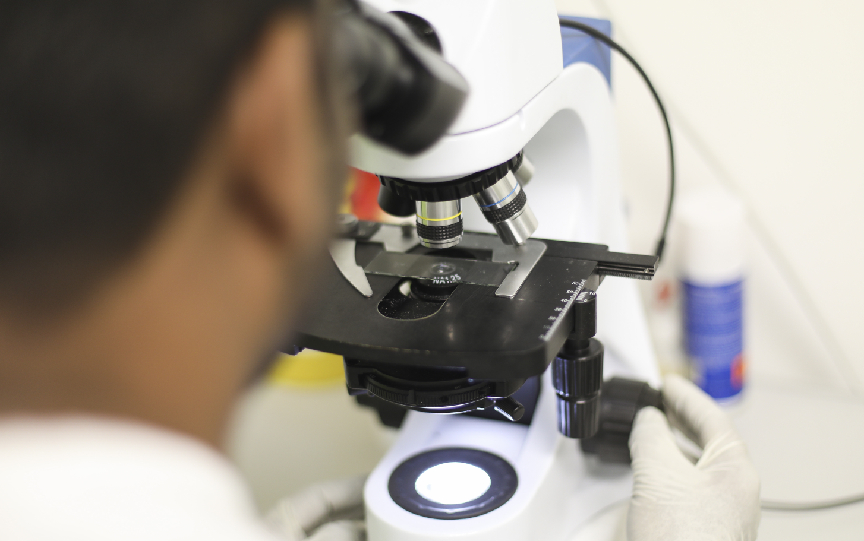Quantitative mapping of human hair greying and reversal in relation to life stress
Ayelet M Rosenberg, Shannon Rausser, Junting Ren, Eugene V Mosharov, Gabriel Sturm, R Todd Ogden, Purvi Patel, Rajesh Kumar Soni, Clay Lacefield, Desmond J Tobin, Ralf Paus, Martin Picard
Elife, 2021
Hair fibres hold a ‘picture’ of a person’s recent life events in the patterns of hair pigmentation and proteins expressed over time which can now be ‘read’ using digital technology. Hair greying is a visible sign of aging that affects everyone. The loss of hair colour is due to the loss of melanin, a pigment found in the skin, eyes and hair. Research in mice suggests stress may accelerate hair greying, but there is no definitive research on this in humans, despite this being very widely believed.
Rosenberg et al. now report a new way to digitize and measure small changes in colour along single human hairs. Examining single-hairs and matching the patterns to life events could allow researchers to look back in time through a person’s biological history. As hair grows at 1cm per month, each hair shaft is a life-history-timeline, and the authors mapped the changes in hundreds of proteins and found evidence linking reversible greying that matched a short period of stress in the lives of subjects examined. The authors propose a threshold-based mechanism for the temporary reversibility of greying and speculate that such a measurement tool could help diagnose subtle changes that include premature greying and ageing which are, in theory, reversible.
Read the full story:
A Cell Membrane-Level Approach to Cicatricial Alopecia Management: Is Caveolin-1 a Viable Therapeutic Target in Frontal Fibrosing Alopecia?
Ivan Jozic, Jérémy Chéret, Beatriz Abdo Abujamra, Mariya Miteva, Jennifer Gherardini, Ralf Paus
Biomedicines, 2021
Caveolin 1 (Cav-1) is a well-known protein that helps create functional microdomains in cell membranes and is strongly expressed in the bulge region of the hair follicle. Its inflammatory cell signalling functions and location in the HF points to a role in scarring alopecia which has not, until now, been investigated. Scarring alopecia’s are inflammatory hair diseases that currently have no cure. The disease irreversibly damages the hair follicle stem cell population in a number of ways including epithelial-mesenchymal transition (EMT) and collapse of immune privilege. One form of scarring alopecia is frontal fibrosing alopecia (FFA) which, as the name suggests, causes a receding hairline and loss of eyebrow hair which is very distressing for women. It has now been recognised that FFA is growing in incidence, meaning that treatments and ways to study the disease are both urgently needed. In a recent article, Jozic et al propose a new role for Cav-1 in the hair follicle by studying its expression in scalp skin affected by scarring. They postulate that the observed up-regulation of Cav-1 is instrumental in inducing collapse of immune privilege, EMT and the loss of the hair follicle stem cells which effectively disrupts both hair growth but also wound repair. Thus Cav-1 is presented as a new therapeutic target in the treatment of scarring alopecia’s. Their data also provide the first evidence for a therapeutically targetable linkage between olfactory receptors (namely OR2AT4) and Cav1 (by Sandalore) in any human disease context.
Read the full story:
Sensory re-innervation of human skin by human neural stem cell-derived peripheral neurons ex vivo
Chéret J, Piccini I, Gherardini J, Ponce L, Bertolini M, Paus R.
J Invest Dermatol, 2021
Explant culture of human skin is improved when the tissue is re-innervated (July 21)
Human skin models that use explant tissue are often deemed as close as possible to a clinical subject when studying disease or disease intervention. But explants decline in health over time in vitro and one of the main losses is the nerves that are normally in such close communication with the epidermis and hair follicle. However, in a Letter to the Editor published in JID this month, Cheret et al show that explant skin can now be rapidly and efficiently reinnervated with commercially available, human induced pluripotent stem cell derived neuronal stem cells using a well-defined, serum-free, NGF-supplemented culture medium to re-establish an almost physiological sensory reinnervation pattern.
Nerves are integral to skin physiology and many nerve fibres serve neuro-immunomodulatory functions in addition to any sensory ones. Thus, it was fascinating to learn that as the neuronal cells re-innervated the skin tissue in vitro, the populations of mast cells also grew again, although, the authors do concede that full function requires a longer period of time and is more of a challenge. Hair growth control is closely linked to both neuronal cells and mast cells, the latter having been shown to be instrumental in regulation of the hair cycle.
This pioneering work suggest that it is possible to engineer better ex vivo skin explants which opens up opportunities for understanding skin diseases and therapeutic interventions in a more relevant skin model.
Read the full story:
Transduction-induced overexpression of Merkel cell T antigens in human hair follicles induces formation of pathological cell clusters with Merkel cell carcinoma-like phenotype
Thibault Kervarrec, Jérémy Chéret, Ralf Paus, Roland Houben, David Schrama
Exp Dermatol, 2021
Merkel cell (MC) carcinoma is a rare type of skin cancer. In the vast majority of the cases, it is caused by the Merkel cell polyomavirus (MCPyV). After MCPyV integrates into the genome of the host, the oncogenic transformation is believed to occur through the expression of several MCPyV proteins. As the name suggests, MC carcinoma cells are phenotypically reminiscent of normal MCs. However, it is unlikely that MCs themselves are the main target of MCPyV-mediated malignant transformation, as the latter are post-mitotic and not easily infected by MCPyV.
Therefore, the authors postulated that hair follicle (HF)-resident MC progenitors may represent the cell of origin of MCPyV-positive MCC. After transduction of HFs with a lentiviral vector encoding different MCPyV antigens, several clusters of highly mitotic cells that were detached from the HF could be observed; these cells had a morphology similar to that of MC carcinoma cells. In one case, clusters were also observed within the HF, suggesting that the progenitor cell(s) had an epithelial origin.
Despite the limitations of the study (no proof of immortalization and no precise identification of the lentivirus-transduced HF cells, as noted by the authors), the results suggest that MC carcinoma cells may originate from the malignant transformation of epithelial cells present in HFs.


